기아변, 점액변, 푸른 대변, 검은 대변, 혈변, 설사변, 지방변, Starvation stool, Mucous stool, Green stool, Black stool, Bloody stool, Diarrhea stool, Steatorrhea(Fatty stool)
기아 변 Starvation stool
- 어떤 병으로 인해 음식물을 며칠 동안 조금도 먹지 못하고 굶을 때, 또는 어떤 병을 진단 치료하기 위하여 2,3일 동안 음식물을 일절 먹지 못할 때도 대변을 조금 볼 수 있다.
- 이때 본 대변을 기아변이라고 한다.
- 기아변 속에는 위장 점액과 장액, 담즙, 췌장액 등이 조금 섞여 있다.
점액 변 Mucous stool
- 점액이 섞여있는 대변을 점액 변, 또는 곱똥이라고 한다.
- 아무 병이 없는 아이도 점액이 소량 섞인 대변을 정상적으로 가끔 볼 수 있다. 그러나 다음과 같은 경우에도 점액 변을 볼 수 있다.
- 변비로 인해 점액 변을 볼 수 있다.
- 또 변비를 치료하기 위해 변비 치료약을 경구로 섭취하거나 관장치료를 할 때 대변에 점액이 소량 섞여 나올 수 있다.
- 장중첩증 등으로 소장관이나 대장관이 막힐 때도 배가 몹시 아프고 피가 섞인 점액 변을 눌 수 있다.
- 우유 단백 알레르기로 생긴 위장염이나 유당 불내증 등으로 점액 변을 볼 수 있다.
- 우유 단백 알레르기로 인한 유산성 대장염이 있을 때도 점액 변을 볼 수 있다.
- 며칠 동안 아무 음식물을 먹지 않을 때 기아 변을 볼 수 있고 점액이 조금 들어 있는 점액 변을 수 있다.
- 바이러스, 박테리아, 곰팡이, 원충, 기생충 등의 병원체 감염으로 생긴 위염, 소장염, 위장염, 대장염 등으로 점액 변을 볼 수 있다.
- 궤양성 대장염이나 크론스 병(Crohn’s disease) 등 염증성 장 질환으로 점액 변을 볼 수 있다.
- 일반적으로 건강한 소아청소년이 본 정상 대변이나 기아변 속에 섞여 나오는 점액의 양은 아주 적다. 이 경우 점액 변을 한두 번 정도 보다가 그치는 것이 통례이다.
- 그렇지만 세균성 이질이나 장티푸스 위장염 등 박테리아 위장염으로 설사를 할 때는 대변에 섞여 나온 점액의 양은 비교적 많고, 점액과 피가 섞인 대변을 보기도 한다.
- 점액 변을 한두 번 이상 계속 볼 때는 왜 그런 점액 변을 보는지 의사에게 곧 문의해야 한다.
푸른 대변(녹 변) Green stool
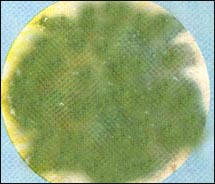
사진 36. 바이러스 감염성 위장염으로 생긴 푸른 설사 변
출처; 소아가정간호 백과 Used with permission from Clinical Educational Aid, Laboratories, Columbus, Ohio, USA
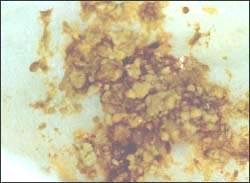
사진 37. 뉴트라미젠(Nutramigen) 인공영양 등을 먹는 영유아들은 정상적으로 푸른 설사 변을 볼 수 있다.
Copyright ⓒ 2011 John Sangwon Lee, MD., FAAP
- 담즙이 간에서 정상적으로 만들어지고 그 담즙은 담관(쓸개관)을 통과해서 십이지장관 속으로 계속 분비된다.
- 그 담즙의 원래 색은 황록색이다.
- 이 녹색 담즙이 십이지장관 속, 소장관 속과 대장관 속을 거쳐 대변 속에 섞여 나오기 전에 소대장관 속에서 소화액과 세균에 의해 변화되어 녹색 담즙이 황갈색 담즙으로 변화되는 것이 정상이다.
- 여러 가지의 원인으로 푸른 대변을 볼 수 있다.
- 특히 영유아들의 위장 연동운동은 일시적으로 쉽게 항진될 때 푸른 대변을 정상적으로 한두 번 정도 볼 수 있다. 그러나 묽고 푸른 설사 변을 한두 번 이상 보거나 그보다 더 자주 보는 것은 비정상적이다.
|
다음은 “점액변”에 관한 인터넷 소아청소년 건강상담 질의응답의 예 입니다. |
Q&A. 점액변 mucous stool
Q.
17개월 된 남자아이 입니다. 2주 전에 장염(점액 변)으로 치료를 받았습니다.
그동안은 괜찮다가(가끔 변 덩어리와 덩어리 사이에 가늘고 짧은 실 같은 게 나왔지만) 오늘 아침에 된변에 코 같은 게 한 덩이 섞여 나왔어요.
밥, 반찬만 먹이고 유제품은 겁이 나서 안 먹이다가 그저께, 어제 요구르트를 조금 먹였는데 그래서 그런 걸까요? 일단 오늘까지 지켜보다가 계속 나오면 병원에 가야겠죠.
왜 자꾸 이럴까요…그래서 아이가 체중미달입니다.
만일 한 두 번 이렇다가 괜찮으면 원인은 정말 요구르트일까요?
우유도 아닌데… 유당 불내증 같은 거라면 우유 섭취는 전혀 불가능한가요?
A.
- 좋은 질문에 감사를 드립니다.
- 자녀의 나이, 성별, 과거 병력, 가족 병력, 진찰소견, 임상검사 등의 정보를 많이 알수록 답변을 드리는데 도움이 됩니다. 주신 정보를 토대로 해서 답변을 드리겠습니다.
- 점액 변을 보게 하는 원인은 많이 있습니다.
- 질문하신 것과 같이, 점액 변을 보게 하는 원인에는
- 원발성 유당 불내증,
- 우유 단백질 알레르기,
- 바이러스 위장염,
- 또는 박테리아 위장염 등이 있습니다.
- 급성 위장염을 앓고 난 바로 후 위장염으로 손상된 위장 벽 점막층의 손상이 완전히 바로 회복되지 않고 며칠 내지 몇 주가 지나가야 위장 점막층이 정상적으로 회복될 수 있습니다.
- 손상된 위장 벽 점막층이 손상되기 전 원래 상태로 되돌아가지 않을 때에 우유나 유당이 들은 음식물을 먹을 때 2차성 유당 불내증이 생겨 우유나 우유가 들어 있는 음식물이 잘 소화되지 않고 가스가 차고 곱이 섞인 대변을 볼 수 있습니다.
- 요구르트는 우유 속에 들어 있는 유당을 유당 효소로 분리해서 포도당과 갈락토오스로 만든 유제 음식물인 줄 압니다.
- 따라서 요구르트를 먹을 때 유당 불내증은 잘 생기지 않는 줄로 알고 있습니다.
- 그러나 요구르트 포장지에 쓰여 있는 요구르트의 성분을 잘 읽어보시고 제가 말씀드린 것이 옳은지 확인하시기 바랍니다.
- 2차성 유당 불내증이 있더라도 먹은 우유 속에 있는 당의 일부가 다소 소화되고 별 증상이 나타나지 않는 경우도 있습니다.
- 그러나 동양인들이나 아프리카 흑인들의 대부분은 유당 불내증을 일생동안 지니고 삽니다.
- 부득이 유당이 들은 음식물이나 우유를 먹을 때 유당효소 성분이 들은 랙트에이드(Lactaid)제 등을 시중에서 사 먹을 수 있습니다.
- 자녀의 경우, 왜 자꾸 곱똥을 누는지 저는 답변을 확실히 드릴 수가 없습니다.
- “한두 번 이러다가 괜찮으면 원인은 정말 요구르트일까요“라는 질문에 답변을 드린다면 “그럴 수도 있습니다.”
- 그러나 유당 불내증은 호흡 공기 수소 측정검사를 해서 진단할 수 있습니다.
- 또 유당을 먹으면서 혈당농도를 측정해서 유당 불내증을 진단할 수도 있습니다.
- 유당 불내증 말고 위장 우유 단백 알레르기로 곱똥을 눌 수도 있습니다.
- “점액 변(Mucous Stool)과 2차성 유당 효소 부족증으로 생기는 설사” 등을 참조하시기 바랍니다.
- 그리고 계속되면 소아청소년과에서 진찰 진단을 받으시고 이 문제에 관해서 상담하시기 바랍니다. 질문이 더 있으시면 다시 연락 주시기 바랍니다. 감사합니다. 이상원 드림
다음과 같은 경우 푸른 대변을 본다.
- 출생 후 신생아가 보는 태변의 색으로 정상적으로 푸를 수 있다.
- 바이러스 위장염이나 박테리아 위장염이 있을 때,
- 정신적으로 불안할 때,
- 주위 환경이 변할 때,
- 우유 단백 알레르기성 위장염이나
- 유당 불 내증
- 또는 그밖에 다른 이유로 위장 연동이 정상 이상으로 항진될 때,
- 무슨 이유로든 소화가 잘 되지 앓을 때,
- 무슨 이유로든 위장 연동이 항진되어 소대장관 내에서 황갈색 담즙이 노란 담즙으로 변화될 수 있는 시간 여유가 없을 때 푸른 대변이 나오게 된다.
- 이때 대게 푸른 설사 변을 본다.
- 0적으로 볼 수 있다.
- 부모도 반의사가 되어야 한다-소아가정간호 백과-제 5권 인공영양, 이유식, 비타민, 미네랄, 지방, 단백질-뉴트라미젠 참조.
- 푸른색 음식물이나 푸른색 약물 등을 먹은 후 푸른 대변을 볼 수 있다.
- 푸른 설사 변이 계속되면 의사에게 문의해서 그 원인이 무엇인지 알고 원인에 따라 치료 받아야 한다.
담즙 Bile
- 담즙(Bile)은 청록색의 액체이고 간세포가 생성한다.
- 수분+담즙염+담즙색소+전해질+콜레스테롤 등이 담즙의 주성분이다.
- 담즙은 특히 지방 소화기능을 돕는다.
|
다음은 “장기간 녹색 변이 계속 되는데요”에 관한 인터넷 소아청소년 건강상담 질의응답의 예 입니다. |
Q&A. 장기간 녹색 변이 계속 되는데요
Q.
- 태어난 지 2개월 24일된 아기입니다.
- 태어나서 가끔은 녹색을 보았으나 10월 8일부터는 녹색변만 봅니다.
- 그 색깔도 점점 진한 녹색으로 되고 있고요.
- 유아관련 책자에서는 장기간 녹색변을 보면 소아청소년과 진찬을 받으라고 했는데 여기서 말하는 장기간은 며칠이고, 그렇다면 우리아기가 병원 가야하는 상태인지 궁급합니다.
- –아기상태–
- 몸무게 : 7.8kg
- 변 횟수 : 1회/1일
- 수유 : 분유, 1일 8회 정도, 3시간마다 120cc(한밤중에도 수유함)
- 기타 : 9월24일부터 10월3일까지 폐렴으로 입원(이 시기에는 설사 증세가 약간 있어 소화제 복용하였으며 노란색 변을 누웠음).
A.
- 선우님
- 안녕하세요. 질문해 주셔서 감사합니다.
- 자녀의 나이, 성별, 과거 병력, 가족 병력, 진찰소견, 임상검사 등의 정보를 많이 알수록 답변을 드리는데 도움이 됩니다. 주신 정보를 토대로 해서 답변을 드리겠습니다.
- p.00 푸른 대변(녹변)을 참조하시기 바랍니다.
- 뉴트라미젠 인공영양을 먹는 신생아, 영아의 경우 정상 정상적으로 푸른 대변을 볼 수 있습니다. 그 외로 푸른 대변(녹변)을 하루에 두세 번 이상 계속 보면 어딘가 이상이 있는 것입니다.
- “장기간”이란 말은 사실 모호한 말입니다. 장기간이란 말 대신 “며칠간 몇 달 또는 그 이상 오랫동안 푸른 똥을 계속 누면”이란 표현이 더 나을 것입니다.
- 그러나 가끔 한두 번 녹변을 본다고 해서 크게 염려할 필요는 없지만 여러 날을 두고 녹변을 보면 그 이유를 꼭 알아야 합니다.
- 자녀의 경우, 우유 단백 알레르기, 음식물을 과량 섭취, 또는 2차성 유당 불내증 등으로 위장염이나 소화불량이 생겨 녹변을 보나 의심이 갑니다.
- 성별은 모르지만 체중은 100퍼센타일 정도 되고 체중이 아주 많이 나가는 아기입니다.
- 신장 치가 얼마 인지 모르기 때문에 성장에 관해서는 더 이상 말씀드리기가 어렵습니다.
- 소아청소년과에서 진찰 진단을 받으시고 이 문제에 대해서 건강 상담을 하시기 바랍니다.
- 설사, 정상변,이상변, 녹변 등을 참조하시기 바랍니다.
- 질문이 더 있으면 다시 연락해 주시기 바랍니다. 감사합니다. 이상원 드림
검은 대변 Black stool
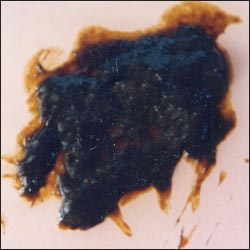
사진 38. 태변
출생 후 신생아들이 본 첫 몇 번 태변의 색은 거의 검은 색이다.
Copyright ⓒ 2011 John Sangwon Lee, MD., FAAP

사진 39. 위장에서 출혈된 새빨간 피가 항문으로 나오기 전에 새빨간 피 색이 검은 피 색으로 변화 될 수 있다. 그 검은 피로 대변 색이 검게 될 수 있다, 대변 잠재혈액(잠 혈/잠복 혈) 검사를 하면 대변에서 피가 섞여 있는지 알 수 있다.
Copyright ⓒ 2011 John Sangwon Lee, MD., FAAP
- 검은 색 대변을 검은 대변이라고 한다.
- 코피가 비강 후부로 흘러 인두 강 속으로 들어간 후 그 코피를 삼킬 수 있다. 그 코피가 식도관 속→위 속→십이지장관 속→소장관 속→대장관 속을 통과해서 대변과 섞여 나오게 된다. 그 코피가 위장을 통과하는 동안 위장 소화액으로 소화되어 붉은색 코피가 검은색 코피로 변할 수 있다. 그럴 때 대변색이 검게 된다.
- 구강, 인두, 식도, 위, 십이지장관, 소장관, 대장관 등에서 난 빨간 피가 항문까지 도달할 때까지 검은 색 피로 변화될 수 있고 대변색이 검게 된다.
- 그 빨간 피가 검은 색 피가 되기도 하고,
- 때로는 커피색과 비슷한 흑갈색 피로 변하기도 하고,
- 일부의 피는 전혀 변화되지 않은 채 새빨갛거나 붉은 피로 대변에 나오든지
- 일부는 변화되어 검은 색 피로 대변에 섞여 있을 수 있다.
- 때로는 새빨간 피만 항문으로 나올 수 있다.
- 삼킨 코피나, 식도나 위장 등에서 나온 출혈의 양, 출혈의 원인에 따라 붉은색 혈변, 검은색 혈변, 커피색 혈변, 검붉은 혈변을 보거나, 대변에 잠혈이 있는 정상 변을 볼 수 있다.
- 대부분의 경우, 대변 속에 피가 소량 섞여 있으면 피가 대변에 섞여 있는지 육안으로 쉽게 볼 수 없다.
- 그렇지만 위장관 등에서 갑자기 피가 많이 날 때는 빨간 피똥(혈변)만 누기도 하고 빨간 피가 섞인 대변을 볼 수 있다. [부모도 반의사가 되어야 한다-소아가정간호 백과]-제 1권 소아청소년 응급의료-피똥을 눌 때 참조, 혈변 참조
- 빈혈을 치료하기 위해 철분제를 섭취할 때, 검은색 음식물을 먹을 때, 검은색 약물을 먹을 때 검은 대변을 볼 수 있다.
- 갓 태어난 신생아가 첫 2~3일 동안 정상적으로 태변을 본다. 태변의 색은 검푸르다.
- 분만 중 질 산도에서 모체의 피를 삼킨 후 태어난 갓 난 아기가 혈변이나 검은 변을 볼 수 있다.
- 모유를 먹는 신생아나 영아가 엄마의 젖꼭지에서 나는 피를 삼킬 수 있고 그 아기는 검은 대변, 또는 붉은 피가 섞인 대변을 볼 수 있다.
- 그 외 어떤 이유로 대변 검사를 하는 중 극소량의 피가 대변 속에 섞여 나오는 것을 육안으로 발견할 때도 있다.
- 육안으로 볼 수 없을 정도로 피가 대변 속에 소량 섞여 있는 것은 잠재혈액(잠복혈/잠혈)이라고 한다.
- 대변에 잠재혈액이 있는지 없는지 알아보는 대변검사를 ‘대변 잠재 혈액검사’ 또는 ‘대변 잠혈 검사’라고 한다.
- 신생아나 영유아가 검은색 대변을 보면 한 번도 사용하지 않은 플라스틱 컵에 받은 대변으로 대변 잠재 혈액 검사를 해서 대변에 잠복혈(잠혈)이 있는지 확인한다.
- 이유를 막론하고, 대변에 붉은 피가 섞여 나오든지, 검은 대변을 볼 때는 의사에게 곧 문의해야 한다.
혈 변(피똥) Bloody stool
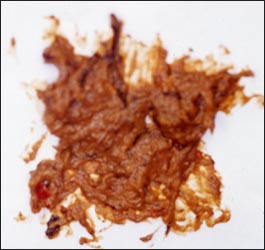
그림 40. 경미한 혈변
Copyright ⓒ 2011 John Sangwon Lee, MD., FAAP
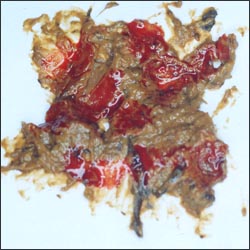
그림 41. 심한 혈변
Copyright ⓒ 2011 John Sangwon Lee, MD., FAAP
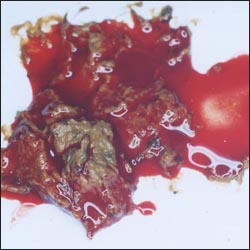
그림 42. 심한 혈변
Copyright ⓒ 2011 John Sangwon Lee, MD., FAAP
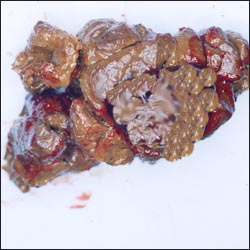
그림 43. 변비와 혈변
Copyright ⓒ 2011 John Sangwon Lee, MD., FAAP
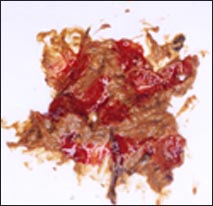
사진 44. 엄마의 젖을 먹는 중 젖꼭지에서 나온 엄마의 피를 빨아 삼켜서 생긴 젖 먹는 아이의 혈변.
Copyright ⓒ 2011 John Sangwon Lee, MD., FAAP
- 피가 섞여 있는 대변을 혈변 또는 피똥이라고 한다.
- 붉은 피가 대변 겉에 조금 묻어나올 수 있다.
- 대변 속에 미량 섞여 나올 수 있다. 이런 대변혈액을 대변 잠재혈(잠재 혈액/잠복혈/잠혈)이라고 한다.
- 대변을 거의 다 본 후 빨간 피만 몇 방울 내지 항문 밖으로 소량 나올 수 있고,
- 피가 대변의 속과 겉에 동시 섞인 혈변을 눌 수 있고,
- 대변은 조금도 나오지 않고 순 피만 항문을 통해 다량 눌 수 있다.
- 변비 변을 눌 때나 다른 원인으로 생긴 항문 치열에서 피가 몇 방울, 소량 눌 수 있다.
- 입안, 비강, 식도관, 위, 십이지장관, 소장관, 대장관 등에서 피가 짧은 시간 동안 다량 날 때 새빨간 피가 대변과 함께 다량 나올 수 있다. 이런 출혈을 위징 출혈이라고 한다.
- 식도 궤양, 위궤양, 십이지장 궤양 등 소화성 궤양, 또는 멕켈 게실염(Meckel’s diverticulitis) 등에서 피가 소량 또는 다량 날 수 있고 혈변을 눌 수 있다.
- 혈소판 감소증으로 전신성 출혈이 생길 수 있고 위장에서 출혈 할 수 있고 그에 따라 혈변을 볼 수 있다.
- 백혈병이나 전신 출혈성 질환 등이 있을 때 위장에서 출혈할 수 있고 그에 따라 혈변을 눌 수 있다.
- 위장염, 위장 폴립, 식도 하부 정맥류 파열 등으로 위장에서 다량 출혈 할 수 있고 새빨간 피가 대변으로 다량 나올 수 있다.
- 육안으로 대변 속에 피가 있는지 식별할 수 없는 미소량 피를 잠복혈(잠혈/잠재혈액/ 분변잠혈/Fecal occult blood)이라 한다(p.00 변비증, p.00 검은 대변, p.00 신생아 혈변, p.00 피똥을 눌 때 참조).
- 대변 속에 피가 소량이나 미량 섞여 있을 때는 대변 잠혈 검사(대변 잠혈 시험, 대변 잠복혈 검사)를 하면 대변에 피가 섞여 있는지 알 수 있다.
|
다음은 “아이 변이 빨개요. 혈 변?”에 관한 인터넷 소아청소년 건강상담 질의응답의 예 입니다. |
Q&A. 아이 변이 빨개요. 혈 변?
Q.
- 안녕하세요. 수고가 많으십니다. 전 5살 그리고 6개월 된 아이 엄마입니다.
- 6개월 된 여자 아이가 뇌수막염으로 10일 정도 입원했다가 8월 1일에 퇴원 했는데 이번에는 감기(모세 기관지염)에 걸렸습니다. 병원 다니면서 치료를 하고 있는데 8월7일부터 변 색깔이 빨갛습니다. 설사를 하고 양은 평상시와 같구요. 평상시에도 변을 묽게 보는 편입니다
- 기저귀가 온통 벽돌색깔이예요. 다 피같지는 않구요. 8일에만 두 번 싸고 나머지는 하루에 한 번씩 변을 봅니다. 먹는 것도 잘 먹고 잠도 잘 자고 컨디션은 아주 좋아 보입니다.
- 병원에서 검사를 했더니 피가 섞여 나오고 염증은 없다고 합니다. 피의 양이 어느 정도인지는 알 수가 없구요. 초음파검사로도 이상이 없다고 해서 대변 배양검사를 하고 있는 중입니다.
- (10일에 검사가 들어감) 오늘이 4일째인데 그냥 검사결과가 나올 때까지 기다리고 있어야 하는지 큰 병원으로 가봐야 하는지 답답합니다. 수고스럽겠지만 빠른 답변 부탁드립니다.
A.
- 유준님
- 안녕하세요. 질문해 주셔서 감사합니다. 좋은 질문입니다.
- 자녀의 나이, 성별, 과거 병력, 가족 병력, 진찰소견, 임상검사 등의 정보를 많이 알수록 답변을 드리는데 도움이 됩니다. 주신 정보를 토대로 해서 답변을 드리겠습니다.
- 걱정이 많이 되시겠습니다.
- 피똥을 누는 원인은 다음과 같이 여러 가지가 있습니다.(p.00혈변 참조)
- 가령 1차적으로 뇌막염을 일으킨 박테리아나 바이러스 등이 이차적으로 위장에 감염되어 위장염이 생길 때 그로 인해서 피똥을 눌 수 있습니다.
- 박테리아 뇌막염 등 감염병 치료에 쓴 항생제 부작용으로 생긴 위장염 ,
- 세균 교대 감염 등으로 인한 위장염,
- 아이브프로펜(Ibuprofen)이나 아스피린(Aspirin) 등 해열 진통제치료를 받을 때 약물 유해 작용으로 인한 위장 출혈이 생길 수 있고 피똥을 눌 수 있습니다.
- 우유 단백이 들은 인공영양 섭취로 생긴 위장 우유 단백질 알레르기로 인한 위장 출혈,
- 그 외 뇌막염을 일으켰던 세균과 관련이 없는 바이러스 위장염, 박테리아 위장염 또는 다른 병원체 감염으로 생긴 위장염으로 대변에 피가 나올 수 있습니다.
- 그 외에도 혈소판 기능 장애나
- 혈소판 부족증,
- 또는 혈액응고 인자 이상으로 위장출혈이 생길 수 있고 그로 대변에 피가 나올 수 있고
- 장 폴립이 있어도 위장 출혈이 생기고 그로 인해서 변에 피가 나올 수 있습니다.
- 위장염,
- 궤양성 대장염이나
- 크론병 등 염증성 장질환 등으로 대변에 피가 나올 수 있습니다.
- 이 것 말고 더 많은 혈변의 원인이 있습니다.
- 소아청소년과에서 진찰 진단을 다시 받으시고 이 문제에 대해서 상담하시기 바랍니다.
- [부모도 반의사가 되어야 한다–소아가정간호 백과]-제 1권 소아청소년 응급의료–피똥을 눌 때. 피똥을 눌 때, 직장 출혈 등을 참조하시기 바랍니다. 질문이 더 있으면 다시 연락해 주시기 바랍니다. 감사합니다. 이상원 드림
설사 변 Diarrhea stool
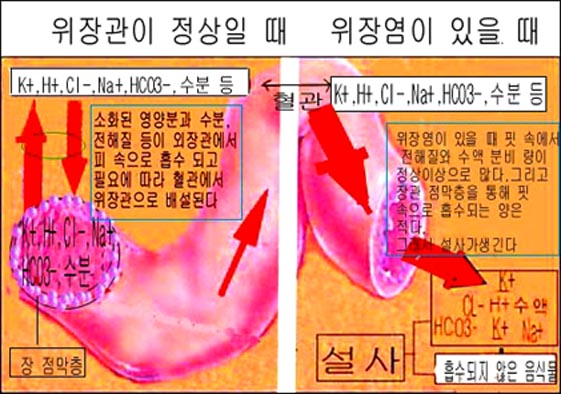
그림 45. 위장이 정상일 때와 위장에 위장염이 있을 때의 전해질, 수분 등이 흡수 분비되고 분비되는 기전과
가 생기는 기전.
- 위장염 등으로 위장 벽 점막층이 손상되거나 부어 설사를 할 때 K⁺, H⁺, Cl⁻, Na⁺, HCO3⁻ 등의 전해질 이온과 장액(소화액)이 소화되지 않은 음식물과 같이 대변으로 배설될 수 있다.
- 이런 변을 설사 변이라고 한다.
- K⁺(포타시움 이온), H⁺(수소 이온), Cl⁻(클로라이드 이온), Na⁺(나트륨 이온), HCO3⁻(중탄산 이온)
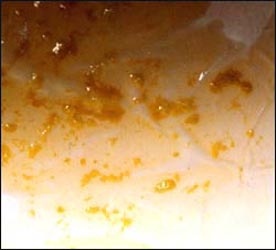
사진 46. 설사 변
설사 변 성분 속에 K⁺, H⁺, Cl⁻, Na⁺, HCO3⁻ 등의 전해질 이온이 들어있고 수분이 많이 들어있다.
Copyright ⓒ 2011 John Sangwon Lee, MD., FAAP

사진 47. 설사 변 성분에 수분이 정상 이상으로 많이 들어있다.
설사 변의 수분은 먹은 음식물에서 나온 수분과 혈관 내 혈액 속에 있던 수분(수액)이 섞인 것이다.
거기다가 위장액(소화액)도 섞여 있다.
Copyright ⓒ 2011 John Sangwon Lee, MD., FAAP
- 보통으로 본 대변의 수분의 양보다 수분의 양이 더 많고 대변의 형태가 없고 대변이 액체 같고 섭취한 음식물이 일부 소화되지 않거나 조금도 소화되지 않은 상태로 눈 비정상적인 대변을 설사 변이라고 한다.
지방 변 Steatorrhea(Fatty Stool)
|
다음은 “아기의 변이 이상해요, 지방변?”에 관한 인터넷 소아청소년 건강상담 질의응답의 예 입니다. |
Q&A. 아기의 변이 이상해요, 지방변?
Q.
- 안녕하세요. 저는 5월 29일 태어난 쌍둥이 아기의 엄마입니다.
- 궁금한 것이 있어서 문의해 봅니다.
- 쌍둥이 중에 한 아이의 변이 기름기가 너무 많아서 엉덩이를 씻길 때 아이의 엉덩이와 저의 손이 끈끈한 기름으로 뒤덮여서 비누를 쓰지 않으면 닦이지 않을 정도입니다.
- 변은 색깔이나 냄새는 정상인 것 같은데 계속 변을 찔기는 편이고 하루에 5~6회 정도 봅니다.
- 양은 매번 그리 많은 편은 아니고 변을 보며 울 때도 있습니다.
- 태어날 때 2.45kg으로 태어나 지금은 약 4kg정도입니다. 체중의 느는 속도는 비교적 정상이며 태어난 지 33일 만에 열이 나서 병원에 입원해서 약 7일정도 항생제를 투여 받았습니다.
- 다행히 다른 이상은 없었구요.
- 빠른 답변을 부탁합니다.
A.
- 청아님
- 안녕하십니까. 좋은 질문해 주셔서 감사합니다.
- 아기의 나이, 성별, 과거 병력, 가족 병력, 진찰소견, 임상검사 등을 종합해서 병을 진단 치료하는 것이 이상적이지만 주신 정보를 토대로 해서 답변을 드리겠습니다.
- 어떤 이유로 음식물에 있는 지방이 잘 소화되지 않고 변으로 그대로 나오는 것 같습니다.
- 자녀의 월령이 얼마인지 모르겠습니다만 체중을 보고 짐작하면 4개월 정도 되었나 생각합니다.
- 우선 대변에 기름기(지방)가 많은 섞여 있는지 알아야겠습니다.
- 만일 대변에 기름기가 많이 섞여 있다면 왜 기름기가 많은지 원인부터 알아야 합니다. 생리적으로 대변에 기름기가 좀 더 많을 수도 있습니다.
- 그렇게 대변에 기름기가 좀 더 많은 대변을 생리적 지방변(Physiologic steatorrhea)이라고 합니다.
- 다음과 같은 병으로 비정상적으로 대변에 기름기가 더 많이 나올 수 있습니다.
- 췌장 이상이나
- 소아 지방변증 등으로 먹은 지방이 잘 소화되지 않을 때 대변에 기름기가 더 많이 생길 수 있습니다. 그런 때는 자녀의 경우와 같이 대변을 본 후 엉덩이를 씻길 때 기름기가 있을 수 있습니다. 그 외 대변에 지방(기름기)이 더 많이 나올 수 있는 병들이 여러 가지 더 있습니다.
- 크론 병(크론씨 병),
- 췌장 낭포성 섬유병,
- 췌장 효소분비 이상,
- 간염,
- Shwachman’s 증후군,
- 회장 수술 제거 등으로 지방이 대변에 비정상적으로 더 많이 나올 수 있습니다.
- 또 너무 많은 지방 음식물을 섭취하거나
- 지방성분이 들은 약물을 섭취할 때 지방이 대변에 더 많이 나올 수 있습니다.
- 자녀가 잘 성장하는 것을 보니 생리적 지방변으로 그런 증상 징후가 생기는 것 같습니다.
- 생리적 지방변은 자연적으로 없어집니다.
- 그러나 일단 소아청소년과 전문의의 진단과 치료를 받으시기를 바랍니다.
- 질문이 더 있으시면 다시 연락 주세요. 감사합니다. 이상원.
Starvation stool, mucous stool, blue stool, black stool, bloody stool, diarrheal stool, fatty stool Starvation stool, Mucous stool, Green stool, Black stool, Bloody stool, Diarrhea stool, Steatorrhea (Fatty stool)
Starvation stool
• You may have a small amount of stool when you starve without eating for several days due to a certain disease, or when you do not eat at all for two or three days for diagnosis and treatment of a certain disease.
• This stool is called starvation.
• Gastrointestinal mucus, intestinal juice, bile, and pancreatic juice are mixed in a little.
Mucous stool
• Stool mixed with mucus is called mucous feces or feces.
• A child without any medical conditions can have occasional, normal stools with small amounts of mucus. However, mucous stools may also be seen in the following cases:
• You may have mucous stools due to constipation.
• Also, a small amount of mucus may be mixed in the stool when taking orally taking medicine for constipation or taking an enema to treat constipation.
• When the small intestine or large intestine is blocked due to intussusception, etc., the stomach hurts very much and bloody mucous stool can be pressed.
• Mucus stool may be due to gastroenteritis caused by milk protein allergy or lactose intolerance.
• You may have mucous stools when you have lactic acid colitis due to a milk protein allergy.
• You may have starvation and mucous stools with little mucus when you do not eat for several days.
• Mucus stool can be seen with gastritis, enteritis, gastroenteritis, colitis, etc. caused by infection with pathogens such as viruses, bacteria, fungi, protozoa, and parasites. • Inflammatory bowel diseases such as ulcerative colitis or Crohn’s disease can cause mucous stools.
• In general, the amount of mucus mixed in normal or starved stools seen by healthy children and adolescents is very small. In this case, it is customary to have a mucous stool once or twice before stopping.
• However, when diarrhea caused by bacterial gastroenteritis such as bacterial dysentery or typhoid gastroenteritis, the amount of mucus in the stool is relatively large, and the stool is mixed with mucus and blood.
• If you keep having mucus stools more than once or twice, you should immediately ask your doctor why you are having such mucus.
Blue stool (green stool)

Photo 36. Blue diarrheal stool caused by viral infectious gastroenteritis source; Encyclopedia of Pediatric and Family Nursing Used with permission from Clinical Educational Aid, Laboratories, Columbus, Ohio, USA

Photo 37. Infants who are fed Nutramigen artificial nutrition, etc. can normally see blue diarrhea. Copyright ⓒ 2011 John Sangwon Lee, MD., FAAP
• Bile is normally made by the liver, and the bile passes through the bile duct (the bile duct) and continues to be secreted into the duodenum.
• The original color of the bile is yellow-green.
• Before this green bile passes through the duodenum, small intestine and large intestine and is mixed with feces, it is normal for green bile to be changed to yellowish brown bile by digestive juices and bacteria in the small intestine.
• There are various causes of blue stool.
• In particular, when gastrointestinal peristalsis in infants and young children is temporarily and easily exaggerated, blue stools can be seen once or twice normally. However, it is not unusual to have one or two or more frequent, watery, blue diarrheal stools.
The following is an example of Internet pediatric health consultation Q&A regarding “mucous stool”.
Q&A. mucous stool
Q. He is a 17 month old boy. I was treated for enteritis (mucous stools) 2 weeks ago. In the meantime, it was fine (sometimes a thin and short thread came out between the lump of stool), but this morning, a lump of something like a nose was mixed with the soybean stool. I only ate rice and side dishes, but I didn’t eat dairy products because I was afraid, but the day before yesterday and yesterday, I ate a little yogurt, so maybe that’s why? If you keep watching until today, you will have to go to the hospital. Why do you keep doing this…so the child is underweight. If once or twice is fine, is the yogurt really the cause? It’s not even milk… Is it impossible to consume milk if you have lactose intolerance?
A.
• Thanks for the good questions.
• The more information you have, such as your child’s age, gender, past medical history, family history, examination findings, and clinical tests, the more helpful it is to give you an answer. We will give you an answer based on the information you provided.
• There are many causes of mucous stools.
• As you asked, the causes of mucus stool include:
• primary lactose intolerance;
• Milk protein allergy;
• viral gastroenteritis;
• or bacterial gastroenteritis.
• Immediately after suffering acute gastroenteritis, the damage to the mucous membrane of the stomach wall damaged by gastroenteritis does not completely recover immediately, and it may take several days or weeks for the gastric mucosa to recover normally.
• Secondary lactose intolerance occurs when you eat food containing milk or lactose when the mucosal layer of the gastrointestinal wall does not return to its original state before damage You can see it.
• Yogurt is thought to be an emulsion food made from glucose and galactose by separating the lactose in milk with lactose enzyme.
• So, I know that lactose intolerance is rare when eating yogurt.
• However, please read the yogurt’s ingredients carefully on the yogurt packaging to make sure what I said is correct.
• Even if you have secondary lactose intolerance, some of the sugar in the milk you eat may be digested to some extent and you may not experience any symptoms.
• However, most Asians and African Americans are lactose intolerant for life.
• When eating food or milk containing lactose inevitably, you can purchase Lactaid containing lactose enzyme from the market.
• In the case of children, I can’t give you a definitive answer as to why you keep poking.
• If the answer to the question, “If it’s okay to do this once or twice, is yogurt really the cause?”, you would say, “Maybe.”
• However, lactose intolerance can be diagnosed with a breath air hydrogen test.
• You can also diagnose lactose intolerance by measuring your blood sugar level while eating lactose.
• Other than lactose intolerance, gastrointestinal milk protein allergy may cause poop.
• See “Mucous Stool and Diarrhea Caused by Secondary Lactose Insufficiency”, etc.
• And if it continues, please see a pediatrician and consult about this problem. If you have any more questions, please feel free to contact us again. Thank you. Lee Sang-won .
Blue stools if:
• After birth, the color of meconium seen by newborns may be normally blue.
• When you have viral gastroenteritis or bacterial gastroenteritis;
• When you are mentally unstable,
• When the surrounding environment changes,
• Milk protein allergic gastroenteritis or
• Lactose intolerance
• When gastrointestinal peristalsis is more than normal, or for any other reason; • When you suffer from indigestion for any reason,
• Blue stool is produced when, for whatever reason, the gastrointestinal peristalsis is hyperactive and there is not enough time for the yellowish-brown bile to change into yellow bile in the small intestine.
• At this time, you usually have blue diarrheal stools.
• It can be viewed as zero.
• Parents Should Be Anti-Doctors – Encyclopedia of Pediatric and Family Nursing – Volume 5 Artificial Nutrition, Baby Food, Vitamins, Minerals, Fats, Proteins – See Neutramigen.
• Blue stool after eating blue food or blue drugs.
• If the blue diarrhea stool persists, you should contact your doctor to find out what is causing it and get treatment based on the cause.
Bile
• Bile is a blue-green liquid and is produced by hepatocytes.
• Water + bile salts + bile pigments + electrolytes + cholesterol are the main components of bile.
• Bile aids in fat digestion, especially.
The following is an example of a Q&A on health counseling for children and adolescents on the Internet about “green stools continue for a long time.”
Q&A. Long-term green stools
Q.
• Your baby is 2 months and 24 days old.
• I have seen green sometimes since I was born, but from October 8, I only see green stools.
• Its color is also getting darker green.
• In the infant booklet, if you see green stools for a long period of time, you should consult a pediatrician, but the long-term here is a few days, so I am wondering if my baby needs to go to the hospital.
• -Baby status-
• Weight: 7.8kg
• Number of stools: 1 time/day
• Feeding: Formulated milk, about 8 times a day, 120cc every 3 hours (feeds in the middle of the night)
• Others: Hospitalized for pneumonia from September 24 to October 3 (During this time, I had mild diarrhea and took digestive medicine and had yellow stools).
A.
• Sunwoo
• Good morning. Thanks for asking.
• The more information you have, such as your child’s age, gender, past medical history, family history, examination findings, and clinical tests, the more helpful it is to give you an answer. We will give you an answer based on the information you provided.
• Please refer to blue stool (green stool).
• Newborns and infants taking Nutramigen artificial nutrition can have normal blue stools. In addition, if you continue to see blue stools (green stools) two or three times a day, something is wrong.
• The term “long term” is actually ambiguous. Instead of “long-term,” you’d be better off saying, “If you continue to have blue poop for a few days, months or longer.”
• However, there is no need to worry too much if you occasionally have green stools once or twice, but if you have green stools over several days, you must know the reason.
• In the case of a child, gastroenteritis or indigestion due to milk protein allergy, excessive intake of food, or secondary lactose intolerance, resulting in green stool, is suspicious. • I don’t know your gender, but your baby weighs about 100 percent and is very overweight. • It’s hard to say any more about your growth because you don’t know what your height is.
• Please visit the Department of Pediatrics for diagnosis and health consultation about this problem.
• Please refer to diarrhea, normal stool, abnormal stool, green stool, etc.
• If you have more questions, please contact us again. Thank you. Lee Sang-won .
Black stool

Photo 38. Meconium The first few meconiums that newborns see after birth are almost black. Copyright ⓒ 2011 John Sangwon Lee, MD., FAAP

Picture 39. The bright red blood color may change to black blood before the bleeding red blood from the stomach comes out of the anus. The black blood can make the stool black. A stool occult blood (occult blood/latent blood) test can tell if there is blood in the stool. Copyright ⓒ 2011 John Sangwon Lee, MD., FAAP
• Black stool is called black stool.
• The nosebleed can flow into the posterior nasal cavity and into the pharyngeal cavity, where it can be swallowed. The nosebleed passes through the esophagus tube → stomach → duodenum → small intestine → large intestine and is mixed with feces. As the nosebleeds pass through the stomach, they are digested with gastric juices, which can turn red nosebleeds into black nosebleeds. When this happens, the stool becomes black.
• Red blood from the oral cavity, pharynx, esophagus, stomach, duodenum, small intestine, and large intestine may change to black blood until it reaches the anus, and stool color becomes black.
• The red blood becomes black blood,
• Sometimes it turns into dark brown blood similar to coffee,
• Some blood may not be changed at all, and it may appear bright red or red blood in the stool.
• Some may be altered and mixed with black blood in the stool.
• Sometimes only bright red blood can come out of the anus.
• Red bloody stool, black bloody stool, coffee-colored bloody stool, dark red bloody stool, or normal stool with occult blood in the stool depending on the swallowed nosebleed, amount of bleeding from the esophagus or stomach, and the cause of the bleeding.
• In most cases, if there is a small amount of blood in the stool, it is not easy to see if there is blood in the stool.
• However, when there is a lot of blood suddenly in the gastrointestinal tract, etc., only red blood feces (blood stool) or stool mixed with red blood may be seen. www.drleepediatrics.com]-Volume 1 Emergency Medical Care for Children and Adolescents-See when pressing blood, see bloody stool
• Black stool may occur when taking iron supplements to treat anemia, eating black foods, or taking black drugs. Newborns have normal meconium during the first 2-3 days. The color of meconium is dark blue.
• Newborns born after swallowing mother’s blood in the vaginal birth canal during labor may have bloody or dark stools.
• Breastfed newborns or infants may swallow blood from their mother’s nipples and the baby may have black or red bloody stools.
• Sometimes, for some other reason, during a stool examination, a small amount of blood may be found in the stool.
• A small amount of blood in the stool that cannot be seen with the naked eye is called occult blood (latent blood/occult blood).
• A stool test to determine whether there is occult blood in the stool is called a fecal occult blood test or a fecal occult blood test.
• If a newborn or infant has black stool, a stool occult blood test is performed with stool from an unused plastic cup to check for latent blood (occult blood) in the stool.
• See your doctor right away if you have red blood or black stools in your stool for any reason.
Bloody stool

Figure 40. Mild blood in stool Copyright ⓒ 2011 John Sangwon Lee, MD., FAAP

Figure 41. Severe bloody stools Copyright ⓒ 2011 John Sangwon Lee, MD., FAAP

Figure 42. Severe bloody stools Copyright ⓒ 2011 John Sangwon Lee, MD., FAAP

Figure 43. Constipation and bloody stools Copyright ⓒ 2011 John Sangwon Lee, MD., FAAP

Photo 44. Bloody stools in a suckling baby caused by sucking and swallowing the mother’s blood from her nipples while breastfeeding. Copyright ⓒ 2011 John Sangwon Lee, MD., FAAP
• Bloody stool is called bloody stool or bloody stool.
• There may be some red blood on the outside of the stool.
• A small amount may be mixed in the stool. Such fecal blood is called fecal occult blood (latent blood/latent blood/occult blood).
• Only a few drops of red blood or small amounts of red blood may come out of the anus after almost completing the stool;
• Blood in the stool can be mixed with the inside and outside at the same time,
• No stool comes out and only pure blood can be pushed through the anus in large quantities. • Constipation A few drops or small amounts of blood may be squeezed from the anal fissure caused by pressing the stool or other causes.
• When there is a lot of blood in the mouth, nasal cavity, esophagus, stomach, duodenum, small intestine, large intestine, etc. for a short period of time, a lot of bright red blood may come out along with the stool. This type of bleeding is called Weijing bleeding.
• In peptic ulcers such as esophageal ulcers, stomach ulcers, duodenal ulcers, or Meckel’s diverticulitis, there may be small or large amounts of blood and bloody stool. • Thrombocytopenia may result in systemic bleeding and bleeding from the stomach, resulting in bloody stools.
• If you have leukemia or a systemic hemorrhagic disease, you may bleed from the stomach and thus have bloody stools.
• Gastroenteritis, gastrointestinal polyps, rupture of lower esophageal varices, etc. may cause a large amount of bleeding from the stomach and a large amount of bright red blood in the stool.
• A very small amount of blood that cannot be visually identified whether there is blood in the stool is called occult blood (occult blood/latent blood/fecal occult blood) (p.00 Constipation, Black stool, Blood in newborns) , when pressing blood poop).
• If there is a small amount or traces of blood in the stool, a stool occult blood test (fecal occult blood test, stool occult blood test) can be performed to determine if there is blood in the stool.
The next one is, “My baby’s stool is red.
This is an example of Internet pediatric health counseling
Q&A regarding “Blood stool?”
Q&A.
The baby’s stool is red. bloody stool?
Q. • Good morning. You work hard. I am a mother of a 5 year old and 6 month old child.
• A 6-month-old girl was hospitalized for 10 days with meningitis and was discharged on August 1, this time with a cold (bronchitis). She is being treated at the hospital and she has had her stools red since August 7th. She has diarrhea and the amount is normal. I usually have loose stools.
• The diapers are all brick color. Not all blood. She wraps twice a day for only 8 days, and defecates once a day for the rest. She eats well, sleeps well, and looks very good.
• When she was tested at the hospital, she said there was blood and there was no inflammation. I don’t know how much blood she has. She said that there was nothing wrong with the ultrasound examination, so she is doing a stool culture test.
• (Testing starts on the 10th) Today is the 4th day and I’m confused as to whether I should just wait for the test results or go to a big hospital. Sorry for the trouble, but I hope for a quick reply.
A
• Yoo Jun-nim • Good morning. Thanks for asking. That’s a good question.
• The more information you have, such as your child’s age, gender, past medical history, family history, examination findings, and clinical tests, the more helpful it is to give you an answer. We will give you an answer based on the information you provided.
• You must be very worried.
• There are several causes of bloody stool as follows. (Refer to bloody stool)
• For example, when the bacteria or virus that caused meningitis first infect the stomach and cause gastroenteritis, it can cause blood feces.
• Gastroenteritis caused as a side effect of antibiotics used to treat infectious diseases such as bacterial meningitis;
• Gastroenteritis due to bacterial shift infection, etc.;
• When taking antipyretic analgesics such as Ibuprofen or Aspirin, gastrointestinal bleeding due to adverse drug effects may occur and blood feces may be pressed.
• Gastrointestinal bleeding due to gastrointestinal milk protein allergy resulting from ingestion of artificial nutrition containing milk protein;
• Any other viral gastroenteritis not related to the bacteria that caused the meningitis, bacterial gastroenteritis, or gastroenteritis caused by an infection with another pathogen may cause blood in the stool.
• In addition, platelet dysfunction or
• thrombocytopenia;
• or gastrointestinal bleeding due to a blood clotting factor abnormality resulting in blood in the stool;
• Even if you have intestinal polyps, your stomach may bleed, which may result in blood in your stool.
• gastroenteritis;
• Ulcerative colitis or
• Blood in the stool may occur due to inflammatory bowel disease such as Crohn’s disease.
• There are many more causes of bloody stools other than these.
• Please visit the Department of Pediatrics again for a diagnosis and discuss this issue.
• www.drleepediatrics.com – Volume 1 Emergency Medical Care for Children and Adolescents – When pressing blood poop. When pressing blood poop, please refer to rectal bleeding, etc. If you have any more questions, please contact us again. Thank you. Lee Sang-won.
Diarrhea stool

Figure 45. Mechanisms of absorption, secretion, and secretion of electrolytes and water when the stomach is normal and when there is gastroenteritis the mechanism by which it occurs. • When the mucous membrane of the stomach wall is damaged or swollen due to gastroenteritis, etc., electrolyte ions such as K⁺, H⁺, Cl⁻, Na⁺, and HCO3⁻ and intestinal fluid (digestive fluid) may be excreted in the feces along with undigested food. have.
• These stools are called diarrheal stools.
• K⁺ (potassium ion), H⁺ (hydrogen ion), Cl⁻ (chloride ion), Na⁺ (sodium ion), HCO3⁻ (bicarbonate ion) Copyright ⓒ 2011 John Sangwon Lee, MD., FAAP

Photo 46. Diarrheal stool Electrolyte ions such as K⁺, H⁺, Cl⁻, Na⁺, and HCO3⁻ are contained in diarrheal stools and contain a lot of water. Copyright ⓒ 2011 John Sangwon Lee, MD., FAAP

Picture 47. Diarrhea The stool contains more water than normal. Diarrhea The water in the stool is a mixture of the water from the food eaten and the water (sap) in the blood in the blood vessels. In addition, gastric juice (digestive fluid) is also mixed. Copyright ⓒ 2011 John Sangwon Lee, MD., FAAP
• Abnormal stools in the eyes in which the amount of water in the stool is higher than the amount of water in the normal stool, the stool has no form, the stool is liquid, and the ingested food is partially or not digested at all.
Fatty Stool Steatorrhea (Fatty Stool)
The following is an example of Internet pediatric health counseling Q&A regarding “Baby’s stools are strange, fatty stools?”
Q&A. Baby’s stools are weird, fatty stools?
Q.
• Good morning. I am the mother of twin babies born on May 29th. • Ask questions if you have any questions.
• One of the twins’ stools are so greasy that when I wash her ass, her butt and my hands are covered in a sticky oil that won’t come off without soap.
• The color and smell of the feces seem normal, but I tend to poop constantly and see it about 5-6 times a day.
• Sheep don’t always have a lot of them, and sometimes they cry.
• I was born with 2.45 kg and now weighs about 4 kg. The rate of weight gain is relatively normal, and on the 33rd day after she was born, she developed a fever and was hospitalized and was given antibiotics for about 7 days.
• Fortunately, there were no other abnormalities.
• We ask for a quick response.
A.
• Not Cheong
• Hello. Thanks for the nice question.
• It is ideal to diagnose and treat the disease by synthesizing the baby’s age, sex, past medical history, family history, examination findings, and clinical examination, but we will give you an answer based on the information you have provided.
• For some reason, it seems that the fat in the food is not digested well and comes out in the stool.
• I don’t know how old my child is, but I think he’s about 4 months old based on his weight.
• First of all, you need to know if there is a lot of oil (fat) mixed in the stool.
• If your stool is oily, you need to know why it is oily. Physiologically, your stool may be more oily.
• The more oily stool in the stool is called Physiologic steatorrhea.
• The following conditions can cause your stool to be unusually oily.
• Pancreatic abnormalities or
• When the fat you eat is not digested well, such as celiac disease, your stool may become more greasy. In such cases, as in the case of your child, washing your buttocks after a bowel movement may be greasy. There are several other conditions that can cause more fat (oily) in the stool.
• Crohn’s disease (Crohn’s disease);
• pancreatic cystic fibrosis;
• abnormal secretion of pancreatic enzymes;
• hepatitis,
• Shwachman’s syndrome;
• Abnormal excess of fat in the stool, such as by surgical removal of the ileum.
• Eating too many fatty foods or • When you take drugs that contain fat, more fat may be excreted in your stool.
• Seeing your child growing well seems to be a symptom of physiological steatorrhea.
• Physiological steatosis goes away naturally.
• However, we hope that you first receive a diagnosis and treatment from a pediatrician.
• If you have more questions, please contact us. Thank you. Lee Sang-won.
출처 및 참조 문헌 Sources and references
- NelsonTextbook of Pediatrics 22ND Ed
- The Harriet Lane Handbook 22ND Ed
- Growth and development of the children
- Red Book 32nd Ed 2021-2024
- Neonatal Resuscitation, American Academy Pediatrics
- www.drleepediatrics.com 제1권 소아청소년 응급 의료
- www.drleepediatrics.com 제2권 소아청소년 예방
- www.drleepediatrics.com 제3권 소아청소년 성장 발육 육아
- www.drleepediatrics.com 제4권 모유,모유수유, 이유
- www.drleepediatrics.com 제5권 인공영양, 우유, 이유식, 비타민, 미네랄, 단백질, 탄수화물, 지방
- www.drleepediatrics.com 제6권 신생아 성장 발육 육아 질병
- www.drleepediatrics.com제7권 소아청소년 감염병
- www.drleepediatrics.com제8권 소아청소년 호흡기 질환
- www.drleepediatrics.com제9권 소아청소년 소화기 질환
- www.drleepediatrics.com제10권. 소아청소년 신장 비뇨 생식기 질환
- www.drleepediatrics.com제11권. 소아청소년 심장 혈관계 질환
- www.drleepediatrics.com제12권. 소아청소년 신경 정신 질환, 행동 수면 문제
- www.drleepediatrics.com제13권. 소아청소년 혈액, 림프, 종양 질환
- www.drleepediatrics.com제14권. 소아청소년 내분비, 유전, 염색체, 대사, 희귀병
- www.drleepediatrics.com제15권. 소아청소년 알레르기, 자가 면역질환
- www.drleepediatrics.com제16권. 소아청소년 정형외과 질환
- www.drleepediatrics.com제17권. 소아청소년 피부 질환
- www.drleepediatrics.com제18권. 소아청소년 이비인후(귀 코 인두 후두) 질환
- www.drleepediatrics.com제19권. 소아청소년 안과 (눈)질환
- www.drleepediatrics.com 제20권 소아청소년 이 (치아)질환
- www.drleepediatrics.com 제21권 소아청소년 가정 학교 간호
- www.drleepediatrics.com 제22권 아들 딸 이렇게 사랑해 키우세요
- www.drleepediatrics.com 제23권 사춘기 아이들의 성장 발육 질병
- www.drleepediatrics.com 제24권 소아청소년 성교육
- www.drleepediatrics.com 제25권 임신, 분만, 출산, 신생아 돌보기
- Red book 29th-31st edition 2021
- Nelson Text Book of Pediatrics 19th- 21st Edition
- The Johns Hopkins Hospital, The Harriet Lane Handbook, 22nd edition
- 응급환자관리 정담미디어
- Pediatric Nutritional Handbook American Academy of Pediatrics
- 소아가정간호백과–부모도 반의사가 되어야 한다, 이상원 저
- The pregnancy Bible. By Joan stone, MD. Keith Eddleman, MD
- Neonatology Jeffrey J. Pomerance, C. Joan Richardson
- Preparation for Birth. Beverly Savage and Dianna Smith
- 임신에서 신생아 돌보기까지. 이상원
- Breastfeeding. by Ruth Lawrence and Robert Lawrence
- Sources and references on Growth, Development, Cares, and Diseases of Newborn Infants
- Emergency Medical Service for Children, By Ross Lab. May 1989. p.10
- Emergency care, Harvey Grant and Robert Murray
- Emergency Care Transportation of Sick and Injured American Academy of Orthopaedic Surgeons
- Emergency Pediatrics A Guide to Ambulatory Care, Roger M. Barkin, Peter Rosen
- Quick Reference To Pediatric Emergencies, Delmer J. Pascoe, M.D., Moses Grossman, M.D. with 26 contributors
- Neonatal resuscitation Ameican academy of pediatrics
- Pediatric Nutritional Handbook American Academy of Pediatrics
- Pediatric Resuscitation Pediatric Clinics of North America, Stephen M. Schexnayder, M.D.
-
Pediatric Critical Care, Pediatric Clinics of North America, James P. Orlowski, M.D.
-
Preparation for Birth. Beverly Savage and Dianna Smith
-
Infectious disease of children, Saul Krugman, Samuel L Katz, Ann A.
- 제4권 모유, 모유수유, 이유 참조문헌 및 출처
- 제5권 인공영양, 우유, 이유, 비타민, 단백질, 지방 탄수 화물 참조문헌 및 출처
- 제6권 신생아 성장발육 양호 질병 참조문헌 및 출처
- 소아과학 대한교과서
Copyright ⓒ 2014 John Sangwon Lee, MD., FAAP
“부모도 반의사가 되어야 한다”-내용은 여러분들의 의사로부터 얻은 정보와 진료를 대신할 수 없습니다.
“The information contained in this publication should not be used as a substitute for the medical care and advice of your doctor. There may be variations in treatment that your doctor may recommend based on individual facts and circumstances.
“Parental education is the best medicine.